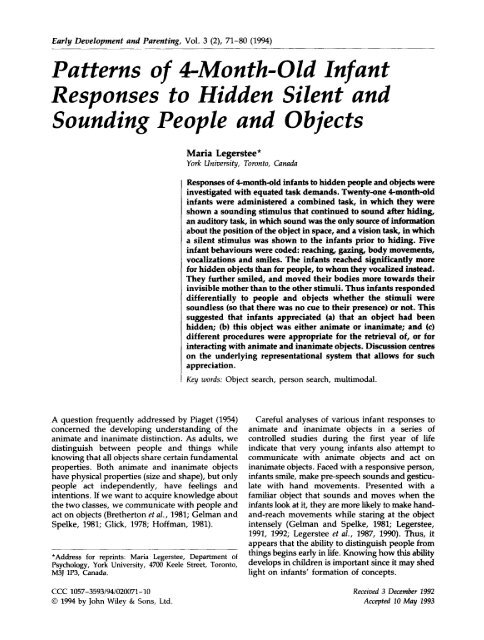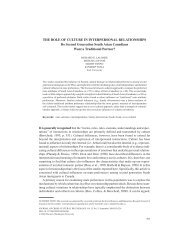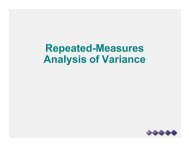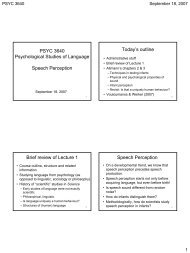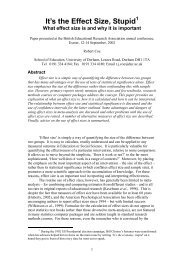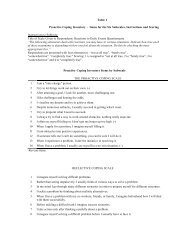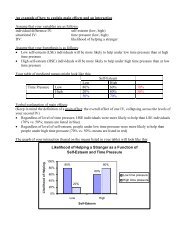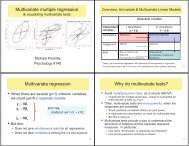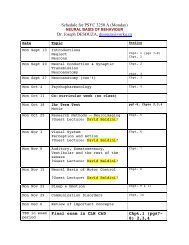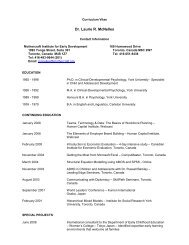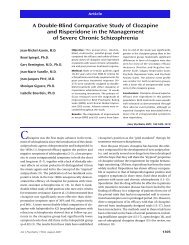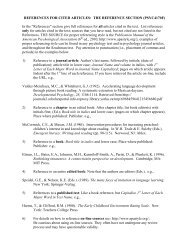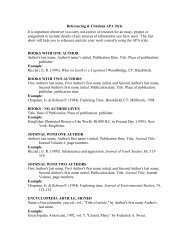Patterns of 4-Month-Old Infant Responses to Hidden Silent and ...
Patterns of 4-Month-Old Infant Responses to Hidden Silent and ...
Patterns of 4-Month-Old Infant Responses to Hidden Silent and ...
Create successful ePaper yourself
Turn your PDF publications into a flip-book with our unique Google optimized e-Paper software.
~~~ -<br />
Early Development <strong>and</strong> Parenting, Vol. 3 (2), 71-80 (1994)<br />
~.<br />
<strong>Patterns</strong> <strong>of</strong> 4-<strong>Month</strong>-<strong>Old</strong> <strong>Infant</strong><br />
<strong>Responses</strong> <strong>to</strong> <strong>Hidden</strong> <strong>Silent</strong> <strong>and</strong><br />
Sounding People <strong>and</strong> Objects<br />
Maria Legemtee*<br />
York University, Toron<strong>to</strong>, Canada<br />
<strong>Responses</strong> <strong>of</strong> 4month-old infants <strong>to</strong> hidden people <strong>and</strong> objects were<br />
investigated with equated task dem<strong>and</strong>s. Twenty-one Cmonth~dd<br />
infants were administered a combined task, in which they were<br />
shown a sounding stimulus that continued <strong>to</strong> sound after hiding,<br />
an audi<strong>to</strong>ry task, in which sound was the only m e <strong>of</strong> information<br />
about the position <strong>of</strong> the object in space, <strong>and</strong> a vision task, in which<br />
a silent stimulus was shown <strong>to</strong> the infants prior <strong>to</strong> hiding. Five<br />
infant behaviours were coded: reaching, gazing, body movements,<br />
vocalizations <strong>and</strong> smiles. The infants reached significantly more<br />
for hidden objects than for people, <strong>to</strong> whom they vocalized instead.<br />
They further smiled, <strong>and</strong> moved their bodies more <strong>to</strong>wards their<br />
invisible mother than <strong>to</strong> the other stimuli. Thus infants responded<br />
differentially <strong>to</strong> people <strong>and</strong> objects whether the stimuli were<br />
soundless (so that there was no cue <strong>to</strong> their presence) or not. This<br />
suggested that infants appreciated (a) that an object had been<br />
hidden; (b) this object was either animate or inanimate; <strong>and</strong> (c)<br />
different procedures were appropriate for the retrieval <strong>of</strong>, or for<br />
interacting with animate <strong>and</strong> inanimate objects. Discussion centres<br />
on the underlying representational system that allows for such<br />
appreciation.<br />
Key words: Object search, person search, multimodal.<br />
A question frequently addressed by Piaget (1954)<br />
concerned the developing underst<strong>and</strong>ing <strong>of</strong> the<br />
animate <strong>and</strong> inanimate distinction. As adults, we<br />
distinguish between people <strong>and</strong> things while<br />
knowing that all objects share certain fundamental<br />
properties. Both animate <strong>and</strong> inanimate objects<br />
have physical properties (size <strong>and</strong> shape), but only<br />
people act independently, have feelings <strong>and</strong><br />
intentions. If we want <strong>to</strong> acquire knowledge about<br />
the two classes, we communicate with people <strong>and</strong><br />
act on objects (Brether<strong>to</strong>n et al., 1981; Gelman <strong>and</strong><br />
Spelke, 1981; Glick, 1978; H<strong>of</strong>fman, 1981).<br />
*Address for reprints: Maria Legerstee, Department <strong>of</strong><br />
Psychology, York University, 4700 Keele Street, Toron<strong>to</strong>,<br />
M3J 1P3, Canada.<br />
CCC 1057-3593/94/020071-l0<br />
0 1994 by John Wiley & Sons, Ltd.<br />
Careful analyses <strong>of</strong> various infant responses <strong>to</strong><br />
animate <strong>and</strong> inanimate objects in a series <strong>of</strong><br />
controlled studies during the first year <strong>of</strong> life<br />
indicate that very young infants also attempt <strong>to</strong><br />
communicate with animate objects <strong>and</strong> act on<br />
inanimate objects. Faced with a responsive person,<br />
infants smile, make pre-speech sounds <strong>and</strong> gesticulate<br />
with h<strong>and</strong> movements. Presented with a<br />
familiar object that sounds <strong>and</strong> moves when the<br />
infants look at it, they are more likely <strong>to</strong> make h<strong>and</strong><strong>and</strong>-reach<br />
movements while staring at the object<br />
intensely (Gelman <strong>and</strong> Spelke, 1981; Legerstee,<br />
1991, 1992; Legerstee et al., 1987, 1990). Thus, it<br />
appears that the ability <strong>to</strong> distinguish people from<br />
things begins early in life. Knowing how this ability<br />
develops in children is important since it may shed<br />
light on infants’ formation <strong>of</strong> concepts.<br />
Received 3 December 1992<br />
Accepted 10 May 1993
72 M. Legerstee<br />
For instance, it is not clear whether this<br />
differential responsiveness <strong>to</strong>wards visible stimuli<br />
is the result <strong>of</strong> perceptual or conceptual differentiation.<br />
Perceptual differentiation is based on<br />
a set <strong>of</strong> perceptual-mo<strong>to</strong>r schemas that would allow<br />
the infant <strong>to</strong> recognize a variety <strong>of</strong> objects <strong>and</strong> their<br />
functions when the objects are present. Conceptual<br />
differentiation on the other h<strong>and</strong> is based on some<br />
type <strong>of</strong> mental representation <strong>of</strong> objects <strong>and</strong> their<br />
functions, <strong>and</strong> entails some rudimentary notion <strong>of</strong><br />
what a person or object is (M<strong>and</strong>ler, 1992).<br />
Piaget (1954) felt that human infants go through<br />
a lengthy period during which they do not think.<br />
He suggested that only near the end <strong>of</strong> the<br />
sensorimo<strong>to</strong>r stage <strong>of</strong> development, at about 18-24<br />
months, do infants learn how <strong>to</strong> represent the world<br />
in a conceptual manner. Prior <strong>to</strong> that, infants<br />
represent the world by means <strong>of</strong> action schemas,<br />
but are not able <strong>to</strong> form concepts that can be recalled<br />
when the stimulus is absent. Thus, infants can learn<br />
<strong>to</strong> recognize things, <strong>and</strong> will smile at famiLiar people,<br />
or reach for objects. Recognition <strong>of</strong> the voice <strong>of</strong> the<br />
mother or <strong>of</strong> the functions <strong>of</strong> objects is evidence <strong>of</strong><br />
a perceptual process which Piaget called ’recogni<strong>to</strong>ry<br />
assimilation’. Perceptual recognition includes<br />
several components: (1) discrimination, when for<br />
instance, the infant discriminates between various<br />
objects; (2) recognition, when infants know they<br />
have seen, felt or heard an object before; <strong>and</strong><br />
(3) identification, as when the infant has learned<br />
that an object can be manipulated in a certain way.<br />
Recogni<strong>to</strong>ry assimilation is based on mo<strong>to</strong>r<br />
knowledge, <strong>and</strong> is only available when some aspect<br />
<strong>of</strong> the object is present. Thus, it should be<br />
distinguished from knowledge that can be brought<br />
<strong>to</strong> consciousness in the absence <strong>of</strong> perceptually<br />
available stimulation (Bremner, 1988; Sylvester-<br />
Bradley, 1985; Harris, 1983; M<strong>and</strong>ler, 1990).<br />
Conceptual or symbolic thought does not only mean<br />
that infants can use language, but the infants can<br />
now underst<strong>and</strong> that objects continue <strong>to</strong> exist when<br />
perceptually inaccessible. Piaget proposed that only<br />
after infants have acquired the concept <strong>of</strong><br />
permanence do they begin <strong>to</strong> differentiate people<br />
from objects on their ‘innate’ social dimensions<br />
(communication, feelings, intentions, etc.).<br />
Piaget cited several reasons why the object<br />
concept would take such a long time <strong>to</strong> be<br />
constructed. First, infants need considerable mo<strong>to</strong>r<br />
activity <strong>and</strong> physical manipulations with objects<br />
before they can underst<strong>and</strong> their permanence.<br />
Second, Piaget proposed that at birth the senses are<br />
unconnected. Until infants come <strong>to</strong> recognize<br />
correspondences between information perceived<br />
through different modalities, ‘stable sensorimo<strong>to</strong>r<br />
schemas <strong>of</strong> three-dimensional, solid, soundproducing,<br />
textured objects cannot be formed,<br />
<strong>and</strong> hence cannot be thought about’ (M<strong>and</strong>ler,<br />
1990, p. 237).<br />
Several researchers have supported Piaget’s<br />
accounts <strong>of</strong> animism, object permanence <strong>and</strong><br />
intersensori-coordination. They have suggested that<br />
prior <strong>to</strong> stage IV <strong>of</strong> the sensorimo<strong>to</strong>r period infants<br />
do not appear <strong>to</strong> distinguish between people <strong>and</strong><br />
things (Decarie <strong>and</strong> Ricard, 1981; Frye et al., 1983;<br />
Sylvester-Bradley, 1985; see Legerstee, 1992 for a<br />
review <strong>of</strong> these studies), nor do they search for<br />
people <strong>and</strong> objects (Bell, 1970; Jackson et al., 1978).<br />
Furthermore, infants do not search for sounding<br />
objects until they begin <strong>to</strong> search for non-sounding<br />
objects (Bigelow, 1983; Uzgiris <strong>and</strong> Benson, 1980;<br />
Piaget, 1954).<br />
However, the st<strong>and</strong>ard Piagetian recall tasks<br />
(lifting up clothes <strong>to</strong> retrieve objects) involve<br />
perceptual <strong>and</strong> mo<strong>to</strong>r skills that are only available<br />
in late infancy (cf. M<strong>and</strong>ler, 1990; Spelke, 1988). It<br />
is possible that the infant’s mo<strong>to</strong>r limitations have<br />
been confounded with conceptual limitations. It<br />
seems that infants who have been allowed <strong>to</strong> show<br />
their underst<strong>and</strong>ing <strong>of</strong> objects in simpler tasks<br />
appear quite competent. First, they do use sound<br />
cues <strong>to</strong> guide their behaviour. Five-<strong>to</strong>-seven monthold<br />
infants not only oriented their gazes <strong>to</strong>wards<br />
a sound, but reached <strong>to</strong>wards it in the dark (Clif<strong>to</strong>n<br />
et al., 1991a, 1991b; Stack et al., 1988; Wishart et al.,<br />
1978). In addition <strong>to</strong> audi<strong>to</strong>ry-tactile coordination,<br />
much about the object appeared <strong>to</strong> be provided by<br />
the visual system alone. In recent reviews, Spelke<br />
(1988) <strong>and</strong> Baillargeon (1992) revealed that by<br />
4 months, infants perceive boundaries <strong>of</strong> objects<br />
<strong>and</strong> they expect objects <strong>to</strong> be substantial, since they<br />
show surprise if objects move through other objects.<br />
Thus it appears that before infants have had<br />
extensive physical manipulations with objects they<br />
perceive them as solid, sound-producing <strong>and</strong><br />
bounded. More importantly, however, very young<br />
infants appear capable <strong>of</strong> recall. Hood <strong>and</strong> Willatts<br />
(1986) presented 5- <strong>to</strong> 6-month-old babies with an<br />
object either <strong>to</strong> the right or <strong>to</strong> the left side. They<br />
were prevented from reaching by their mother until<br />
the lights went out. After the objects had become<br />
invisible <strong>and</strong> the infants’ h<strong>and</strong>s were released, the<br />
authors found that infants reached more <strong>to</strong> where<br />
the object had been seen than <strong>to</strong> the wrong side.<br />
Thus, infants remembered not only the position,<br />
but also the existence <strong>of</strong> invisible objects.<br />
Thus the above data not only indicate considerable<br />
sophisticated perceptual knowledge about
<strong>Responses</strong> <strong>to</strong> <strong>Hidden</strong> People <strong>and</strong> Objects 73<br />
objects but also suggest that such young infants<br />
represent absent information. That conceptual<br />
development is possible without the benefit <strong>of</strong><br />
active experience with the object has been suggested<br />
by research with physically h<strong>and</strong>icapped infants.<br />
Apparently, infants with mo<strong>to</strong>ric restrictions may<br />
show near normal conceptual development (Bebko<br />
et al., 1992).<br />
If very young infants represent knowledge about<br />
objects qua objects, then they should be able <strong>to</strong><br />
conceptualize that there are different kinds <strong>of</strong><br />
objects (Piaget, 1954; M<strong>and</strong>ler, 1988). As we have<br />
noted earlier, by 4 months <strong>of</strong> age infants<br />
communicate with people <strong>and</strong> manipulate things.<br />
If infants have learned that the out <strong>of</strong> sight<br />
transformations do not affect the status <strong>of</strong> the object,<br />
then infants may use these different types <strong>of</strong><br />
responses when they want them <strong>to</strong> be recovered.<br />
Thus, they would call for people, but act on objects<br />
in order <strong>to</strong> bring them back <strong>to</strong> view.<br />
The following experiment was conducted <strong>to</strong><br />
investigate this hypothesis. To discern whether<br />
4-month-old infants would react differently <strong>to</strong><br />
hidden objects than <strong>to</strong> hidden people, their<br />
responses were observed in conditions where<br />
people <strong>and</strong> objects were hidden in silence. To<br />
discern whether infants would use sound in their<br />
behavioural manifestations, the infants were also<br />
presented with people <strong>and</strong> objects that continued<br />
<strong>to</strong> sound after hiding, <strong>and</strong> in conditions where<br />
sound was the primary source <strong>of</strong> information about<br />
the position <strong>and</strong> identity <strong>of</strong> the object in space.<br />
Because it has been shown that familiarity <strong>of</strong> stimuli<br />
influences search behaviour in infants (Bell, 1970;<br />
Jackson et aZ., 1978), the infants were further<br />
presented with familiar <strong>and</strong> novel people <strong>and</strong><br />
objects. The infants’ gazes, smiles, vocalizations,<br />
body <strong>and</strong> arm movements <strong>to</strong> their disappearing<br />
mother, a female stranger, familiar <strong>and</strong> novel<br />
objects were measured. It was hoped that the use<br />
<strong>of</strong> this more elaborate coding scheme would tap the<br />
infants’ growing underst<strong>and</strong>ing <strong>of</strong> the range <strong>of</strong><br />
attributes that differentiates people from things <strong>and</strong><br />
would reveal more detailed information about the<br />
developing strategies infants use in their search for<br />
different objects (Gelman <strong>and</strong> Spelke, 1981).<br />
METHOD<br />
Subjects<br />
Twenty-eight 4-month-old infants (17 girls <strong>and</strong><br />
11 boys) had been r<strong>and</strong>omly selected from birth lists<br />
provided by the Grace Maternity Hospital in Halifax<br />
(Nova Scotia, Canada). Of this initial sample, the<br />
data from two girls were lost because they cried<br />
excessively. The data from another four girls <strong>and</strong><br />
one boy had <strong>to</strong> be discarded since these infants had<br />
emitted reaches, vocalizations <strong>and</strong> body movements<br />
prior <strong>to</strong> the closing <strong>of</strong> the exit door. Because it is<br />
possible that the infants’ subsequent behaviours <strong>to</strong><br />
the invisible stimulus were continuations <strong>of</strong><br />
behaviours <strong>to</strong> the visible stimulus, these data could<br />
not therefore be used. The final data set consisted<br />
<strong>of</strong> responses from 21 infants (10 boys, 11 girls), at<br />
4 months (mean age=4.3 months, SD= k3.2 days),<br />
from mostly white, middle-class families as judged<br />
from parental educational levels. Most infants had<br />
one or more siblings.<br />
Apparatus<br />
A large wooden box, fastened on four wooden legs,<br />
was used for hiding. It measured 75 cm high, 75 cm<br />
wide <strong>and</strong> 62 cm in depth. The legs were 65 cm in<br />
height. Total playbox height was 140cm. The<br />
playbox was open in the front. The two sides were<br />
made <strong>of</strong> solid wood with a door (28 cm high) each<br />
that when opened was large enough for a person’s<br />
head or a <strong>to</strong>y <strong>to</strong> be put through. The back <strong>of</strong> the<br />
playbox was also made <strong>of</strong> solid wood. An opening<br />
<strong>of</strong> 23 x 75 cm allowed an adult <strong>to</strong> hold the infant<br />
from behind by the waist (see Figure 1).<br />
<strong>Infant</strong> behavioural activities <strong>and</strong> facial expressions<br />
at either hiding place were filmed with two video<br />
cameras mounted on a wall facing the front <strong>of</strong> the<br />
box, but above <strong>and</strong> <strong>to</strong> the side <strong>of</strong> the infant’s head<br />
<strong>and</strong> therefore out <strong>of</strong> their visual field. One camera<br />
had a zoom lens, <strong>and</strong> was remotely controlled by<br />
a camera opera<strong>to</strong>r from a separate control room.<br />
This enabled her <strong>to</strong> continue filming the baby’s<br />
responses whenever the baby changed position.<br />
Using a split-screen genera<strong>to</strong>r, the pictures <strong>of</strong> the<br />
two cameras were recorded on one VCR (JVC BR<br />
9050U) that contained a date-time genera<strong>to</strong>r <strong>to</strong><br />
record onset <strong>and</strong> <strong>of</strong>fset <strong>of</strong> the sessions <strong>and</strong> <strong>of</strong> the<br />
various behaviours.<br />
Type <strong>of</strong> Objects<br />
The infants were presented with their mother, a<br />
female stranger <strong>and</strong> a familiar <strong>and</strong> novel object in<br />
the vision, audi<strong>to</strong>ry <strong>and</strong> combined tasks. The<br />
unfamiliar objects used for the sessions consisted<br />
<strong>of</strong> a bright orange <strong>and</strong> yellow snorkel doll, a blue<br />
<strong>and</strong> white smurfette (see Figure l), a bright pink<br />
<strong>and</strong> white doll <strong>and</strong> a brown <strong>and</strong> yellow bear. Two
74 M. Legerstee<br />
Figure 1. Playbox used <strong>to</strong> equate task dem<strong>and</strong>s in search for people <strong>and</strong> objects.<br />
different objects were used during the combined<br />
<strong>and</strong> vision novel object condition; the other two<br />
were used during the familiarization condition.<br />
During the object conditions that required sound,<br />
the <strong>to</strong>ys produced a sound through speakers stuffed<br />
in<strong>to</strong> their bodies <strong>and</strong> wired <strong>to</strong> a recorder that played<br />
the various sounds (squeaky, rattle-like, bells or<br />
melody). All objects were approximately 9-10 in. in<br />
height, similar <strong>to</strong> a medium-sized head <strong>of</strong> a female<br />
person. The familiar object was a <strong>to</strong>y that the<br />
mother brought from home that would make sounds<br />
when h<strong>and</strong>led. In the labora<strong>to</strong>ry these sounds were<br />
recorded prior <strong>to</strong> testing <strong>and</strong> then played through<br />
a small speaker attached <strong>to</strong> the back <strong>of</strong> the <strong>to</strong>y<br />
(invisible <strong>to</strong> the infant) in the audi<strong>to</strong>ry conditions.<br />
Thus both the novel <strong>and</strong> familiar <strong>to</strong>ys provided<br />
simultaneous visual <strong>and</strong> audi<strong>to</strong>ry stimulation in the<br />
combined conditions. Mothers <strong>and</strong> female strangers<br />
said ‘Hello (name <strong>of</strong> baby), where am I?’. The<br />
women continued <strong>to</strong> repeat this phrase while<br />
hiding. Pilot work had indicated that all sounds<br />
were clearly audible <strong>to</strong> the infants, since all infants<br />
would turn their heads <strong>to</strong> the onset <strong>of</strong> the sounds.<br />
Different female strangers were used for each<br />
condition.<br />
Procedure<br />
All babies were tested when they were in an alert<br />
<strong>and</strong> attentive state. Prior <strong>to</strong> testing the infants were<br />
familiarized with the table <strong>and</strong> the hiding<br />
procedures by playing games <strong>of</strong> hide <strong>and</strong> seek with<br />
the experimenter <strong>and</strong> some <strong>to</strong>ys, while the mother<br />
held the infant from behind. Stimuli used during<br />
the familiarization session did not interact with the<br />
infant during the experimental sessions. During<br />
testing, the infants were placed in the box facing the<br />
cameras at either the right or the left door <strong>of</strong> the<br />
table. These positions were r<strong>and</strong>omly determined.<br />
A research assistant held the infant from behind.<br />
In order <strong>to</strong> prevent her from biasing the responses<br />
<strong>of</strong> the infant she wore stereophonic earphones<br />
through which music played. She was further<br />
instructed <strong>to</strong> watch over her shoulder <strong>and</strong> away from<br />
the infant <strong>to</strong> a video that recorded the infant’s face.<br />
Thus, she was in a sense deaf <strong>and</strong> blind <strong>to</strong> the<br />
location <strong>of</strong> the various stimuli. At the beginning <strong>of</strong><br />
each task, the infants were turned at a 3h angle<br />
<strong>to</strong>wards the door; the other ‘h <strong>of</strong> their body was<br />
turned <strong>to</strong>wards the front <strong>of</strong> the playbox facing the<br />
cameras. This way the infant’s gaze (head <strong>and</strong> nose<br />
aligned <strong>to</strong> the exit door) <strong>to</strong> where the object was<br />
shown orl<strong>and</strong> sounded was easily scored. The<br />
stimuli were presented <strong>to</strong> the infants at a reaching<br />
distance <strong>of</strong> approximately 30 cm. During the social<br />
<strong>and</strong> non-social vision tasks, the person’s face or the<br />
object was shown <strong>to</strong> the infant through the door.<br />
As soon as the infant fixated the stimulus <strong>and</strong> before<br />
the infant was able <strong>to</strong> respond, the door was closed.<br />
The stimulus was then hidden for 15 seconds.
<strong>Responses</strong> <strong>to</strong> <strong>Hidden</strong> People <strong>and</strong> Objects 75<br />
During the social <strong>and</strong> non-social audi<strong>to</strong>ry tasks,<br />
the person would say ’Hi (baby’s name), where<br />
am I?’, or the object would sound behind the<br />
closed door. The door was then opened <strong>and</strong><br />
closed (without showing the stimulus) while the<br />
person or object continued <strong>to</strong> sound without<br />
becoming visible for 15 seconds. In the social<br />
<strong>and</strong> non-social combined tasks, the person’s face<br />
or the <strong>to</strong>y respectively would be shown <strong>to</strong> the baby<br />
through the door while sounding until the infant<br />
fixated the stimuli. Then the door would close<br />
while the stimuli continued <strong>to</strong> sound for another<br />
15 seconds.<br />
<strong>Infant</strong>s were given only one trial <strong>of</strong> each task <strong>to</strong><br />
eliminate a practice effect. The 12 tasks were also<br />
r<strong>and</strong>omly presented.<br />
Data Scoring<br />
The videotapes were coded by two trained students<br />
na’ive <strong>to</strong> the experimental hypotheses from a TV<br />
moni<strong>to</strong>r with a 53 cm screen. Although the coders<br />
were able <strong>to</strong> see the various stimuli when the doors<br />
opened, they were not aware <strong>of</strong> the experimental<br />
hypotheses <strong>and</strong> therefore could not influence the<br />
results one way or the other. The durations <strong>of</strong> the<br />
following infant-dependent variables were coded<br />
for each <strong>of</strong> the 12 tasks: (1) reaching; (2) body<br />
movements; (3) gazing; (4) smiling; <strong>and</strong> (5) vocalizing.<br />
Although filming had begun as soon as the<br />
stimulus was presented <strong>to</strong> the infant, scoring <strong>of</strong> the<br />
dependent variables commenced with the closing<br />
<strong>of</strong> the door or after the infants turned their heads<br />
<strong>to</strong>wards the sounding invisible stimulus (in the<br />
audi<strong>to</strong>ry condition).<br />
Interobserver reliabilities using the scoring<br />
method were calculated for 30% <strong>of</strong> the data. Cohen<br />
kappas were calculated on agreement <strong>of</strong> the<br />
durations (+1 seconds) <strong>and</strong> frequencies <strong>of</strong> each<br />
behaviour <strong>and</strong> ranged between 0.81 <strong>and</strong> 0.82.<br />
Values greater than 0.75 are considered ’excellent<br />
agreement’ (Fleiss, 1981).<br />
A ‘reach’ was defined as the forward extension<br />
<strong>of</strong> one or both arms away from the body, in the<br />
direction <strong>of</strong> the stimulus <strong>and</strong> while the infants were<br />
gazing at the stimulus (von H<strong>of</strong>sten, 1984). A ’gaze’<br />
was calculated when the infants turned their eyes<br />
<strong>to</strong>wards the sound or the invisible stimulus behind<br />
the exit door. A ’body movement‘ was defined as<br />
a gaze <strong>to</strong>wards the stimulus with the upper <strong>to</strong>rso<br />
leaning forward. ‘Smiles‘ were coded when babies<br />
turned up the corners <strong>of</strong> their mouth without<br />
vocalizing (mouth may be open or closed).<br />
’Vocalizations’ were scored when babies made vocal<br />
sounds. Physiological sounds (burping, hiccups,<br />
<strong>and</strong> cries, etc.) were not scored.<br />
RESULTS<br />
The mean durations <strong>and</strong> st<strong>and</strong>ard deviation <strong>of</strong> each<br />
<strong>of</strong> the infant responses are presented in Table 1. To<br />
determine whether infants would display reliably<br />
different responses <strong>to</strong> hidden social <strong>and</strong> non-social<br />
stimuli, <strong>and</strong> whether sound <strong>and</strong> familiarity <strong>of</strong> the<br />
two classes would influence the responses <strong>of</strong> the<br />
infants, their responses were submitted <strong>to</strong> a<br />
repeated measures ANOVA that would evaluate<br />
the effect <strong>of</strong> condition (combined, audi<strong>to</strong>ry, vision),<br />
stimulus (person, object) <strong>and</strong> familiarity (familiar,<br />
novel). Interactions were analysed post hoc by<br />
planned orthogonal contrasts.<br />
Reaching<br />
A sigruficant main effect for stimulus F(1,20) = 91.54,<br />
p< 0.0001 indicated that infants reached<br />
significantly more for hidden objects than for<br />
hidden people. There was also a significant main<br />
effect for condition F(2,19)=9.46, p
76 M. Legerstee<br />
Table 1. Mean durations <strong>and</strong> st<strong>and</strong>ard deviations <strong>of</strong> infant responses <strong>to</strong> familiar <strong>and</strong> novel, people <strong>and</strong> objects, in<br />
vision, audi<strong>to</strong>ry <strong>and</strong> combined conditions (N= 21)<br />
~ ~~<br />
Condition<br />
Vision<br />
M<br />
SD<br />
Audi<strong>to</strong>ry<br />
M<br />
SD<br />
Combined<br />
M<br />
SD<br />
Stimulus<br />
Person<br />
M<br />
SD<br />
Object<br />
M<br />
SD<br />
Familiarity<br />
Familiar<br />
M<br />
SD<br />
Reach Body Gaze Smile Vocalization<br />
2.36<br />
1.50<br />
2.62<br />
1.60<br />
3.57<br />
1.72<br />
0.86<br />
0.67<br />
4.84<br />
2.25<br />
2.94<br />
1.44<br />
2.56<br />
1.86<br />
4.00<br />
2.66<br />
3.65<br />
2.09<br />
2.68<br />
1.71<br />
6.73<br />
1.56<br />
10.02<br />
2.42<br />
11.53<br />
1.79<br />
9.53<br />
1.74<br />
9.33<br />
1.57<br />
0.85<br />
0.39<br />
1.35<br />
1.28<br />
1.62<br />
1.18<br />
2.36<br />
1.62<br />
0.18<br />
0.03<br />
0.90<br />
0.36<br />
0.85<br />
0.61<br />
0.70<br />
0.33<br />
1.32<br />
0.78<br />
0.31<br />
0.22<br />
2.62 3.71 9.57 1.67 1.11<br />
1.76 1.89 1.36 0.85 0.61<br />
Novel<br />
M 3.08 2.63 9.29 0.87 0.51<br />
SD 1.29 1.82 1.57 0.20 0.44<br />
rn Person<br />
rn Obpcl<br />
Figure 2. Mean durations <strong>of</strong> reaches <strong>to</strong> people <strong>and</strong><br />
objects as a function <strong>of</strong> vision, audi<strong>to</strong>ry <strong>and</strong> combined<br />
conditions.<br />
Person<br />
Obiect<br />
Figure 3. Mean durations <strong>of</strong> body movements as a<br />
function <strong>of</strong> familiar <strong>and</strong> novel people <strong>and</strong> objects.<br />
Gaze<br />
Smiles<br />
A significant main effect for condition A sigruficant main effect <strong>of</strong> stimulus F(1,20)=45.94,<br />
F(2,19) = 74.80, p
I<br />
<strong>Responses</strong> <strong>to</strong> <strong>Hidden</strong> People <strong>and</strong> Objects<br />
.______<br />
~~ _______<br />
77<br />
'1<br />
i<br />
I Familiar<br />
Condition<br />
Figure 4. Mean durations <strong>of</strong> gazes as a fundion <strong>of</strong> vision,<br />
audi<strong>to</strong>ry <strong>and</strong> combined conditions.<br />
'1<br />
Person<br />
6 Farriiliai<br />
6 Novel<br />
Object<br />
Figure 5. Mean durations <strong>of</strong> smiles as a function <strong>of</strong><br />
familiar <strong>and</strong> novel people <strong>and</strong> objects.<br />
post hoc analyses revealed that infants smiled<br />
sigruhcantly more at their mother than at the<br />
stranger F(1,20)= 15.00, p
78 M. Legerstee<br />
their body more in the direction where people were<br />
hiding. This differential responsiveness <strong>to</strong> the<br />
hidden stimuli implies that such young infants have<br />
enduring representations <strong>of</strong> animate <strong>and</strong> inanimate<br />
objects that are no longer visible. Thus not only<br />
were infants aware <strong>of</strong> the continued existence <strong>of</strong><br />
people <strong>and</strong> things, but also <strong>of</strong> their properties. In<br />
particular, the infants seemed <strong>to</strong> acknowledge that<br />
one communicates with people <strong>and</strong> acts on objects.<br />
Although this is only a small segment <strong>of</strong> the<br />
information that differentiates people from things,<br />
it indicates that the concept <strong>of</strong> animism is<br />
developing early in life.<br />
Other researchers have demonstrated a global<br />
concept <strong>of</strong> animism in very young infants.<br />
Apparently, 2-month-old infants will imitate facial<br />
gestures <strong>of</strong> people, but not <strong>of</strong> objects simulating<br />
these gestures (Legerstee, 1991), <strong>and</strong> 7-month-old<br />
infants differentiated between animals <strong>and</strong> vehicles<br />
as different kinds (McDonough <strong>and</strong> M<strong>and</strong>ler, 1992).<br />
These data cannot be explained on the basis <strong>of</strong><br />
perceptual differentiation, since the animate <strong>and</strong><br />
inanimate stimuli were kept perceptually similar in<br />
these studies.<br />
As expected, infants benefited from prior visual<br />
input when searching for sounding objects. Significantly<br />
more infants reached <strong>and</strong> gazed for<br />
inanimate objects, <strong>and</strong> significantly more infants<br />
moved their body <strong>to</strong> their mother in the combined<br />
condition than in the vision or audi<strong>to</strong>ry conditions.<br />
Thus the added effects <strong>of</strong> visual <strong>and</strong> audi<strong>to</strong>ry<br />
stimulation aided infants in their search for hidden<br />
objects. This finding supports studies on intersensory<br />
coordination in infancy showing that the<br />
different modalities function in a coordinated way<br />
in infants (Spelke, 1979; Stack et al., 1988).<br />
Familiarity <strong>of</strong> the social stimulus appeared <strong>to</strong> have<br />
a sigruficant influence on the search activities <strong>of</strong> the<br />
infants. The infants smiled, vocalized <strong>and</strong> turned<br />
their body significantly more <strong>to</strong> where their mother<br />
was hiding than <strong>to</strong> where the other stimuli were<br />
hidden. Thus infants seemed more sensitive <strong>to</strong> the<br />
absence <strong>of</strong> their mother than <strong>to</strong> the disappearance<br />
<strong>of</strong> the other stimuli. Bell (1970), studying infants<br />
between 9 <strong>and</strong> 12 months <strong>of</strong> age, found increased<br />
search for mother over inanimate objects. There are<br />
several reasons why search for mother would be<br />
more intense. The mother is in tune with the<br />
gestures <strong>of</strong> her infant <strong>and</strong> her actions are <strong>of</strong>ten in<br />
synchrony with them (Kaye <strong>and</strong> Fogel, 1980; Murray<br />
<strong>and</strong> Trevarthen, 1985). The developing elaboration<br />
<strong>of</strong> mother-infant interactions, facilitated by familiarity<br />
with each other, results in the mother becoming the<br />
most important <strong>and</strong> stimulating object for the infant<br />
(Stern et al., 1985). It should therefore not be<br />
surprising that her disappearance carries greater<br />
consequences <strong>to</strong> the infant than the disappearance<br />
<strong>of</strong> inanimate objects or unfamiliar people (Gelman<br />
<strong>and</strong> Spelke, 1981; Legerstee, in press).<br />
It could be argued that the various responses <strong>to</strong><br />
people <strong>and</strong> objects were simply continuations <strong>of</strong><br />
actions that had already been set in motion when<br />
the stimulus was shown <strong>to</strong> the infant. However,<br />
only gazing <strong>and</strong> smiling were behaviours that had<br />
their onset prior <strong>to</strong> the response period. The<br />
vocalizations, reaches <strong>and</strong> body movements were<br />
behaviours that had been produced after the<br />
stimulus had been hidden. If the infant responses<br />
had been continuations <strong>of</strong> actions produced <strong>to</strong> the<br />
visual stimulus, then no differential responsiveness<br />
should have been produced during the audi<strong>to</strong>ry<br />
condition in which no prior visual association with<br />
the stimulus had been provided <strong>to</strong> the infants.<br />
Our results showed that the infants responded<br />
differentially according <strong>to</strong> the meaning <strong>of</strong> the<br />
sound. They reached significantly more <strong>to</strong> the<br />
sound emitted by objects <strong>and</strong> they produced more<br />
body movements, vocalizations <strong>and</strong> smiles <strong>to</strong> the<br />
sound produced by people, in particular their<br />
mother. Thus, sound had come <strong>to</strong> indicate the<br />
position <strong>and</strong> the identity <strong>of</strong> a specific object, a<br />
realization that is likely <strong>to</strong> come with the<br />
underst<strong>and</strong>ing that objects continue <strong>to</strong> exist in space<br />
even when out <strong>of</strong> sight (Uzgiris <strong>and</strong> Benson, 1980).<br />
It is also difficult <strong>to</strong> explain these data as the result<br />
<strong>of</strong> conditioning. Although 4month-old infants must<br />
have had plenty <strong>of</strong> experience in bringing back their<br />
caretakers through vocalizing, <strong>and</strong> none doing the<br />
same with objects, it is unlikely that pre-crawling,<br />
Pmonth-old infants have had practice bringing back<br />
invisible inanimate objects through reaching.<br />
Therefore, the infants’ differential responsiveness<br />
<strong>to</strong> the invisible stimuli suggests that infants in these<br />
situations appreciate that: (a) an object has been<br />
hidden; (b) this object is either animate or inanimate;<br />
<strong>and</strong> (c) different procedures are appropriate for the<br />
retrieval <strong>of</strong>, or for interacting with animate <strong>and</strong><br />
inanimate objects. Thus, rather than a conditioned<br />
response, the infants’ differential responsiveness <strong>to</strong><br />
the invisible stimuli suggests the beginnings <strong>of</strong> the<br />
object concept. That infants are capable <strong>of</strong> such<br />
representations has been indicated in previous work<br />
by Hood <strong>and</strong> Willatts (1986). The present study<br />
provides new information about infants’ conceptions<br />
<strong>of</strong> people.<br />
If such young infants are able <strong>to</strong> remember the<br />
location <strong>and</strong> existence <strong>of</strong> hidden people <strong>and</strong> objects,<br />
what does proper search for stimuli depend on?
<strong>Responses</strong> <strong>to</strong> <strong>Hidden</strong> People <strong>and</strong> Objects 79<br />
According <strong>to</strong> Gelman <strong>and</strong> Spelke (1981) <strong>and</strong><br />
M<strong>and</strong>ler (1990), an underst<strong>and</strong>ing that people <strong>and</strong><br />
objects can be returned in different ways should<br />
depend in part on a knowledge <strong>of</strong> objects <strong>and</strong> <strong>of</strong><br />
the various distinctions between them. Thus an<br />
appreciation <strong>of</strong> the object’s separate <strong>and</strong> permanent<br />
existence should not be seen as the end result <strong>of</strong><br />
lengthy interactions with people <strong>and</strong> things, but as<br />
the foundation from which might develop an idea <strong>of</strong><br />
animism which would lead <strong>to</strong> a further refined<br />
conceptual differentiation <strong>of</strong> people <strong>and</strong> objects<br />
(M<strong>and</strong>ler, 1990).<br />
If young infants are able <strong>to</strong> conceptualize things,<br />
the foundations <strong>of</strong> such thoughts cannot lie in the<br />
physical actions with objects since young infants<br />
have not acquired much control over their actions<br />
until 4-5 months <strong>of</strong> age (Bebko et al., 1992; Bushnell,<br />
1985). In a recent review, M<strong>and</strong>ler (1988) <strong>of</strong>fers a<br />
theoretical account for the early appearance <strong>and</strong><br />
further development <strong>of</strong> these conceptualizations.<br />
She suggests that rather than from physical actions,<br />
early concept formation derives from certain<br />
perceptual analyses which are defined as ‘a<br />
symbolic process (probably conscious) by which one<br />
perception is actively compared with another’<br />
(M<strong>and</strong>ler, 1988, p. 126). As an example <strong>of</strong> how<br />
infants might begin <strong>to</strong> form conceptions <strong>of</strong> animate<br />
<strong>and</strong> inanimate objects, she proposes that infants<br />
may perceive the movement <strong>of</strong> animate objects <strong>to</strong><br />
be different in some important <strong>and</strong> specific way<br />
from inanimate objects. This perception is s<strong>to</strong>red,<br />
<strong>and</strong> in subsequent processes animate <strong>and</strong> inanimate<br />
objects are compared with this representation.<br />
Thus, conceptions develop from internal abstractions<br />
that are made specific by the perceptual system<br />
(M<strong>and</strong>ler, 1992). In order <strong>to</strong> determine whether<br />
these speculations have any truth, an investigation<br />
about animate <strong>and</strong> inanimate objects should be <strong>of</strong><br />
interest <strong>to</strong> all concerned with the infant’s earliest<br />
cognitive development.<br />
ACKNOWLEDGEMENTS<br />
This research was funded by a grant from the<br />
Natural Sciences <strong>and</strong> Engineering Research Council<br />
<strong>of</strong> Canada (0116916) <strong>and</strong> the Social Sciences<br />
<strong>and</strong> Humanities Research Council <strong>of</strong> Canada<br />
(410-91-1743). I would like <strong>to</strong> thank the mothers <strong>and</strong><br />
infants who so generously <strong>of</strong>fered their time <strong>and</strong><br />
energy <strong>to</strong> participate in this study. Special thanks<br />
also <strong>to</strong> Johanna Robertshaw, Christina Spiropoulos,<br />
Suzie Kushner, Sarah Bradfield <strong>and</strong> Tina Wentzell<br />
for their assistance in the various phases <strong>of</strong> this<br />
research, <strong>to</strong> Mirka Ondrach, <strong>and</strong> Roman Konarksi,<br />
Institute for Social Research, York University, for<br />
statistical advice.<br />
REFERENCES<br />
Baillargeon, R. (1992). The object concept revisited: new<br />
directions in the investigations <strong>of</strong> infants’ physical<br />
knowledge. In C. E. Graruud (Ed.), Visual Perception in<br />
Infancy. Gzmegie-Mellon Symposia on Cognition, 23.<br />
Hillsdale, NJ: Erlbaum.<br />
Bebko, J., Burke, L., Craven, J. <strong>and</strong> Sarlo, N. (1992). The<br />
importance <strong>of</strong> mo<strong>to</strong>r activity in sensorimo<strong>to</strong>r<br />
development: a perspective from children with physical<br />
h<strong>and</strong>icaps. Human Development, 35, 226-24.<br />
Bell, S. M. (1970). The development <strong>of</strong> the concept <strong>of</strong><br />
object as related <strong>to</strong> infant-mother attachment. Child<br />
Development, 41, 291-311.<br />
Bigelow, A. (1983). Development <strong>of</strong> the use <strong>of</strong> sound in<br />
the search behavior <strong>of</strong> infants. Developmental Psychology,<br />
3, 317-321.<br />
Bremner, G. (1988). lnfancy. Oxford: Basil Blackwell.<br />
Brether<strong>to</strong>n, I., McNew, S. <strong>and</strong> Beeghly-Smith, M. (1981).<br />
Early person knowledge as expressed in gestural <strong>and</strong><br />
verbal communication: when do infants acquire a<br />
‘theory <strong>of</strong> mind’? In M. E. Lamb <strong>and</strong> L. R. Sherrod<br />
(Eds), <strong>Infant</strong> Social Cognition. Hillsdale, NJ: Erlbaum.<br />
Bushnell, E. W. (1985). The decline <strong>of</strong> visually guided<br />
reaching during infancy. Infint Behavior <strong>and</strong> Ddopmnt,<br />
8, 139-155.<br />
Clif<strong>to</strong>n, R., Perris, E. <strong>and</strong> Bullinger, A. (1991a). <strong>Infant</strong>s’<br />
perception <strong>of</strong> audi<strong>to</strong>ry space. 6e&lopmhtal Psychology,<br />
27, 187-197.<br />
Clif<strong>to</strong>n, R. K., Rochat, P., Li<strong>to</strong>vsky, R. Y. <strong>and</strong>Perris, E. E.<br />
(1991b). Object representation guides infants’ reaching<br />
in the dark. Journal <strong>of</strong> Experimental Psychology: Human<br />
Perception <strong>and</strong> Performance, 17, 323-329.<br />
Decanb, T. G. <strong>and</strong> Ricard, M. (1982). La socialisation du<br />
nourisson. La Recherche, 139, 1388-1396.<br />
Fleiss, J. L. (1981). Statistical Methods for Rates <strong>and</strong><br />
Proportions. New York: Wiley.<br />
Frye, D., Rawling, P., Moore, C. <strong>and</strong> Myers, L. (1983).<br />
Object-person discrimination <strong>and</strong> communication at 3<br />
<strong>and</strong> 10 months. Developmental Psychologyt 19,303-309.<br />
Gelman, R. <strong>and</strong> Spelke, E. (1981). The development <strong>of</strong><br />
thoughts about animate <strong>and</strong> inanimate objects:<br />
implications for research on social cognition. In J. H.<br />
Flavell <strong>and</strong> L. Ross (Eds), Social Cognition Development:<br />
Frontiers <strong>and</strong> Possible Futures. New York: Cambridge<br />
University Press, pp. 43-66.<br />
Glick, J. (1978). Cognition <strong>and</strong> social cognition: an<br />
introduction. In J. Glick <strong>and</strong> K. A. Clarke-Stewart (Eds),<br />
The Development <strong>of</strong> Social Underst<strong>and</strong>ing. New York:<br />
Cambridge University Press, pp. 1-9.<br />
Harris, P. L. (1983). Cognition in infancy. In M. M. Haith<br />
<strong>and</strong> J. J. Campos (Eds), InFmcy <strong>and</strong> Biologrcal Deoelopment<br />
(Vol. 2 <strong>of</strong> P. Mussen, Ed., H<strong>and</strong>book <strong>of</strong> Child Psychology,<br />
pp. 689-782). New York: Wiley.<br />
H<strong>of</strong>fman, M. (1981). Perspectives on the difference<br />
between underst<strong>and</strong>ing people <strong>and</strong> underst<strong>and</strong>ing<br />
things: the role <strong>of</strong> affect. In H. Flavell <strong>and</strong> L. Ross (Eds),
80 M. Legerstee<br />
Social Cognition Development: Frontiers <strong>and</strong> Possible Futures.<br />
New York: Cambridge University Press, pp. 67-81.<br />
H<strong>of</strong>sten, C. von (1984). Developmental changes in the<br />
organization <strong>of</strong> prereaching movements. Developmental<br />
Psychology, 20, 378-388.<br />
Hood, B. <strong>and</strong> Willatts, P. (1986). Reaching in the dark <strong>to</strong><br />
an object's remembered position: evidence for object<br />
permanence in 5-month-old infants. British Journal <strong>of</strong><br />
Developmental Psychology, 4, 57-65.<br />
Jackson, E., Campos, J. <strong>and</strong> Fischer, K. W. (1978). The<br />
question <strong>of</strong> decalage between object permanence <strong>and</strong><br />
person permanence. Uevelopmental Psychology, 14,l-10.<br />
Kaye, K. <strong>and</strong> Fogel, A. (1980). The temporal structure <strong>of</strong><br />
face-<strong>to</strong>-face communication between mothers <strong>and</strong><br />
infants. Developmental Psychology, 16, 454-464.<br />
Legerstee, M. (1991). The role <strong>of</strong> people <strong>and</strong> objects in<br />
early imitation. Journal <strong>of</strong> Experimental Child Psychology,<br />
51, 423-433.<br />
Legerstee, M. (1992). A review <strong>of</strong> the animate-inanimate<br />
distinction in infancv: imdications for models <strong>of</strong> social<br />
<strong>and</strong> cognitive know&. Ehrly Development <strong>and</strong> Parenting,<br />
1, 59-67.<br />
Legerstee, M. (in press). The role <strong>of</strong> familiarity <strong>and</strong> sound<br />
in the development <strong>of</strong> person <strong>and</strong> object permanence.<br />
British Journal <strong>of</strong> Developmental Psychology.<br />
Legerstee, M., Corter, C. <strong>and</strong> Kienapple, K. (1990). H<strong>and</strong>,<br />
arm, <strong>and</strong> facial actions <strong>of</strong> young infants <strong>to</strong> a social <strong>and</strong><br />
nonsocial stimulus. Child Deuelopment, 61, 774-784.<br />
Legerstee, M., Pomerleau, Malcuit, G. <strong>and</strong> Feider, H.<br />
(1987). The development <strong>of</strong> responses <strong>to</strong> people <strong>and</strong> a<br />
doll: implications for research in communication. <strong>Infant</strong><br />
Behavior <strong>and</strong> Development, 10, 81-95.<br />
M<strong>and</strong>ler, J. M. (1988). How <strong>to</strong> build a baby: on the<br />
development <strong>of</strong> an accessible representational system.<br />
Cognitive Dmelopment, 3, 113-136.<br />
M<strong>and</strong>ler, J. M. (1990). A new perspective on cognitive<br />
development in infancy. American Scientist, 78 (3),<br />
236-243.<br />
M<strong>and</strong>ler, J. M. (1992). How <strong>to</strong> build a baby: Il. Conceptual<br />
primitives. Psychological Rm'ew, 99, 587-604.<br />
McDonough, L. <strong>and</strong> M<strong>and</strong>ler, J. M. (1992). <strong>Infant</strong><br />
differentiation <strong>of</strong> globally defined categories. Poster<br />
presented at the meetings <strong>of</strong> the International Society<br />
<strong>of</strong> <strong>Infant</strong> Studies, Miami, Fl.<br />
Murray, L. <strong>and</strong> Trevarthen, C. (1985). Emotional<br />
regulation <strong>of</strong> interactions between two-month-olds <strong>and</strong><br />
their mothers. In T. M. Field <strong>and</strong> N. A. Fox (Eds), Social<br />
Perception in <strong>Infant</strong>s. Norwood, NJ: Ablex, pp. 177-197.<br />
Piaget, J. (1954). The Construction <strong>of</strong> Reality in the Child.<br />
New York: Basic Books.<br />
Spelke, E. S. (1988). Where perceiving ends <strong>and</strong> thinking<br />
begins: the apprehension <strong>of</strong> objects in infancy. In A.<br />
Yonas (Ed.), Perceptual Development in Infancy: The<br />
Minnesota Symposia on Child Psychology, Vol. 20.<br />
Hillsdale, NJ: Erlbaum, pp. 197-234.<br />
Stack, D. M., Muir, D. W., Sherriff, F. <strong>and</strong>Roman, J. (1988).<br />
Development <strong>of</strong> infant reaching in the dark <strong>to</strong> luminous<br />
objects <strong>and</strong> 'invisible sounds'. Perception, 18, 69-82.<br />
Stern, D., H<strong>of</strong>er, L., Haft, W. <strong>and</strong> Dore, J. (1985). Affect<br />
attunement: the sharing <strong>of</strong> feeling states between<br />
mother <strong>and</strong> infant by means <strong>of</strong> inter-modal influence.<br />
In T. Field <strong>and</strong> N. Fox (Eds), Social Perception in <strong>Infant</strong>s.<br />
Norwood, NJ: Ablex, pp. 249-268.<br />
Sylvester-Bradley, B. (1985). Failure <strong>to</strong> distinguish<br />
between people <strong>and</strong> things in early infancy. British<br />
Journal <strong>of</strong> Developmental Psychology, 3, 281-292.<br />
Uzgiris, I. C. <strong>and</strong> Benson, J. (1980). <strong>Infant</strong>'s use <strong>of</strong> sound<br />
in the search for objects. Paper presented at the<br />
International Conference on <strong>Infant</strong> Studies, New<br />
Haven, April 1980.<br />
Wishhart, J. G., Bower, T. G. R. <strong>and</strong>Dunkeld, J. (1978).<br />
Reaching in the dark. Perception, 7, 507-512.


